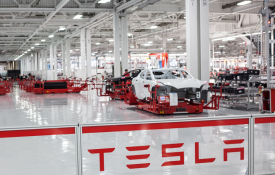Social anxiety, as traditional urban sociology likes to remind us, is just maladjustment to change. But who has anticipated, or adjusted to, the scale of change in Southern California over the last fifteen years?”
– Mike Davis, “City of Quartz,” 1990
From 1876-1887, the Southern Pacific Railroad had a transportation monopoly in Los Angeles and the surrounding territory. The railroad, which owned a significant portion of the land surrounding the tracks on either side, successfully used its influence to force down land prices and drive speculation, thus spurning a massive migration to the southwest. Armed with similar land grants, in 1887, the Santa Fe Railroad established Los Angeles as the terminus for its western route. The two railroads began a fierce price war, dropping ticket costs for cross-country trips, thus throwing fuel on the migration fires. With an influx of population and capital, the land was transformed literally overnight. Irrigation lines were drawn and new towns built every day. The railroads promoted Los Angeles as the city for a healthy future due to its “Mediterranean” qualities; the land not already cordoned off for new cities became citrus groves. A new agricultural center, Los Angeles was poised to come into the 20th-century as a powerhouse.
But the economy collapsed in 1893, the railroad bubble burst, and much of the capital that was set aside for the growth of Los Angeles dried up. Nevertheless, the topography of the land was forever changed.
In August of 2013, Elon Musk released his alpha design of the Hyperloop, the “5th mode” of transportation (following planes, trains, automobiles, and ships). As you read this article, representatives of the California State Assembly are moving forward with a $68 billion high speed train, the majority of which will be researched, developed, and assembled outside of the state. This train will connect Los Angeles to San Francisco in five hours, a remarkable feat, but still slower and with higher ticket prices than flying. Polls show a majority disapproval of the project, and the experts can already see a future mired in land acquisition difficulties, construction impediments, and costly environmental studies.

Illustration by Lon Leven
At the time the railroads were first brought to LA, it was the fastest means of transportation. Their transcontinental construction was a driving factor in the settling of the United States and moved millions of people across this nation. But at the time they were built, the companies were chartered with land grants from Congress delineating their tracks. The only way they were able to do such aggressive building and nation expanding was precisely because they received the full backing of the government during a time when there was no such thing as a populous west. The prospect of a Hyperloop, even with all the difficulties inherent to the project (and I will be the first to say that there are many of them), would drop the commute time between SF and LA to about 30 minutes, and every city linked within 1,000 miles. And you know what? I bet in the time it takes to design, get through all the legal problems, and then finally build the high-speed train (which will no doubt cost more than the initial $68 billion proposed), Musk’s hyperloop could be finished, and LA could again move into yet another booming area of the economy. The railroads revolutionized California more than 100 years ago, but they won’t bring that same sweeping change again. Rather than rest on our haunches, California should follow the Los Angeles model and push as many new technologies into development as possible. It could only help balance the deficit.
Since the American acquisition of the California territory, Los Angeles has either been divided against itself or pitted against an outside force.
Sometimes I find it difficult to comprehend the changes that have taken place in California. Even though I am often on the forefront of the future, it still amazes me to look around and see all the differences between the LA I know now and the LA I first came to. And yet, from what I know of LA’s re-inventive abilities, I’m sure LA will look completely different in another 15 or 20 years. The funny thing is, though, that no one has known what LA was going to look like 15 or 20 years into the future.
In the vast sea we call Southern California, Los Angeles has always been a multi-headed beast of a place. Since the American acquisition of the California territory, Los Angeles has either been divided against itself or pitted against an outside force. As the first wave of settlers crashed onto the LA shores, the new Americans and old Haciendados clashed before intermarrying, their economic fates tied to cattle and the New England Industrial Revolution. Following the Comstock explosion and gold rush of the mid-19th century, Los Angeles saw San Franciscan investments pour in, and with it, Northern Californian interests. With the new northern wealth, the area bristled with competing interests. The old guard fought the new, the locals jostled with the interlopers, and the 19th century wasn’t even half over. The railroads split the population further as they drew lines and built cities from dust and speculation. While oil spurned environmental NIMBYism, the Westside grew in power and wealth, only to come up against the downtown financial sector and the Times. Valley citizens fought with urbanites, race riots permeated the 60s, industry left, aerospace arrived, foreign investment threatened to take away Californian autonomy, and at the end of the 20th century, this city was a mean place.
And why shouldn’t it have been, considering the constant cultural conflict that embroiled LA? But for so long, this was only a two-way fight. Most of these major waves of change that I’m talking about were one-on-one conflicts, and in terms of direct power struggles, there have never been more than two big challengers. But with the dawn of the 20th century, Los Angeles has seen the arrival of a third major power in this city, and for the first time it is united in cause and not in location. The Los Angeles tech industry (in all its forms, as united as they may or may not be) holds an incredibly large amount of sway in this city. The arrival of a third locus of power that isn’t directly tied to the land only means the future of this city is in greater disarray. Yet, despite the unprecedented circumstances, it truly appears as though the tech industry holds a real answer to what LA will look like.
By just having Musk in our midst, Los Angeles is on the edge of the space transportation, renewable energy, and transportation technology industries.
The six industries that are really at the heart of the coming tech revolution are all being developed in the Southland: biotech, space commercialization, renewable and new energy sources, transportation tech, the Internet and the Internet of things, 3D printing, and micro manufacturing. These six industries will shape the future of California and the world. Considering our fair state is the 9th largest economy as of 2012 and would be the size of the 34th most populous nation, it isn’t all that surprising that so much would come from here. Speaking simply about people, LA and the surrounding areas have generated, or played host to, an inordinate number of tech stars.

Though Biotech was first pioneered in Northern California, LA hosts an Amgen branch and Patrick Soon Shiong, the mogul and philanthropist connected to UCLA. In addition to his Hyperloop, Elon Musk calls LA his playground while making his plans for SpaceX and Tesla. By just having Musk in our midst, Los Angeles is on the edge of the space transportation, renewable energy, and transportation technology industries. All together, Musk alone has created thousands of new jobs in California and has spawned some of the most inventive and innovative technologies to grace the Earth in a long time. If you include Solar City, which could become the largest energy distribution company in the world that, (surprise, surpsrise) Musk chairs, LA has almost this entire future in the palm of its hand.
3D printing, heavily developed in Valencia, will soon let loose millions of micro manufacturing niche markets. This will allow any individual with access to the machine to print and create whatever it is they wish, but more importantly, it will allow places that are more remote to maintain themselves more easily. 3D printing will give back global autonomy in a way that hasn’t been seen since the days of conquest and expansion in the 19th century. We can go back to provisional living while still being connected through the World Wide Web. And as for the Internet, Google, Twitter, Facebook, Snapchat and Apple all have major offices in LA responsible for creating and updating the myriad technologies we rely on daily – such as Google Glass, which will surely become a behemoth in no time at all. And if they aren’t based here, then they’re still LA bound, tied up in Silicon Valley and its miasmic ethos. Qualcomm makes your mobile chips; Broadcom makes your high speed signal processors; Intel and Invidia make the hardware in your computer. All told, California is directly responsible for every possible future you could conceive of today.
The question still remains, though, as to whether or not California technology will grab the reigns and assert itself over the future of this state and planet, or will it simply become the third head of the beast that is LA. My gut honestly tells me that it will succeed, considering how close it has become with entertainment, another one of the pillars LA is built upon. In my mind, it seems almost too unlikely for tech to fail where all others haven’t. But I am reminded of LA’s history, and I know that no matter the outcome, I won’t recognize it until it is right on top of me.












































